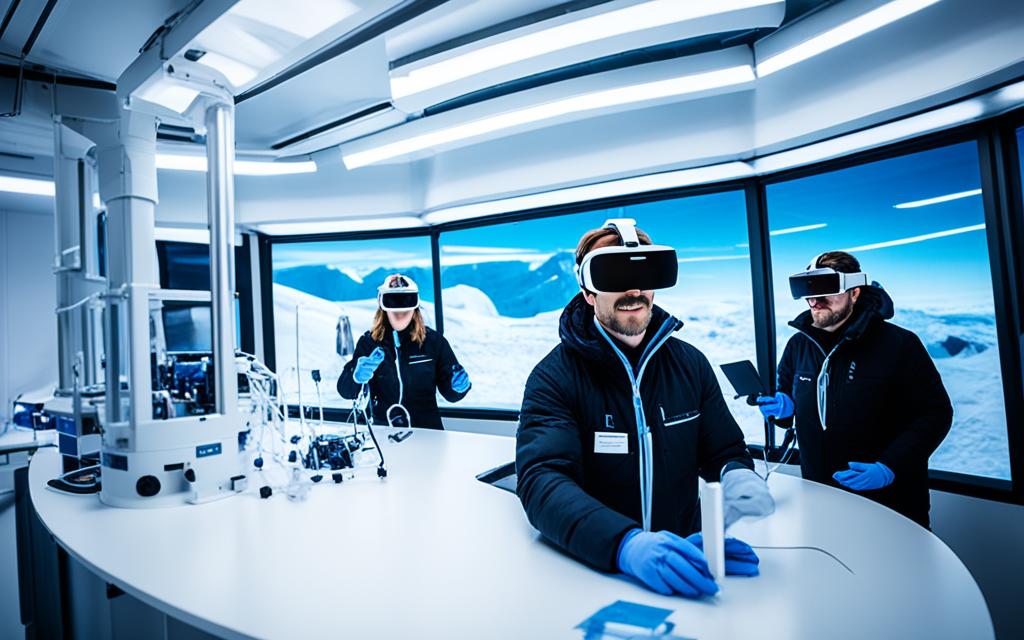Table of Contents
Welcome to a world of exploration and learning with Cambridge Collaboration. As a research-based organization, our mission is to empower learners in achieving their goals and expanding their horizons. We go beyond traditional language learning and delve into the realms of immersive experiences. Embark on an unforgettable Antarctic VR journey as we combine cutting-edge technology with educational expertise.
At Cambridge Collaboration, we believe that effective learning goes hand in hand with a comprehensive understanding of the world. Our research uncovers the most efficient ways to teach and learn and aims to develop valuable skills alongside language proficiency. Through our Antarctic VR journey, we offer learners a unique opportunity to explore the wonders of the icy continent from the comfort of their own homes.
Step into the virtual realm and witness the pristine beauty of Antarctica unfold before your eyes. Immerse yourself in the captivating landscapes, encounter diverse wildlife, and unlock the secrets of this majestic frozen continent. Our virtual reality technology allows you to experience the awe-inspiring sights and sounds, creating a truly immersive and educational adventure.
But our Antarctic VR journey is more than just an exploration. It is a gateway to understanding the complexities of our world. Through this experience, you will discover the negative greenhouse effect, a fascinating phenomenon unique to Antarctica. With rising levels of carbon dioxide and methane, most areas of the world are subjected to a warming effect. However, due to extremely dry conditions and a lack of water vapor, Antarctica experiences a cooling effect instead. This discovery adds a new dimension to the understanding of climate change and highlights the intricacies of our planet’s delicate balance.
Experience the synergy of education and technology with Cambridge Collaboration’s Antarctic VR journey. Join us in uncovering the wonders of Antarctica, expanding your knowledge, and embracing the power of immersive learning. Together, let’s embark on a journey that transcends language barriers and allows us to connect with the world in new and meaningful ways.
Understanding the Negative Greenhouse Effect in Antarctica
Research has discovered a unique phenomenon called the negative greenhouse effect in a specific area of the Antarctic Plateau. Unlike the general warming effect caused by rising levels of carbon dioxide and methane, this effect actually cools the atmosphere due to extremely dry conditions and a lack of water vapor. The presence of water vapor plays a key role in determining the outcome of the greenhouse effect, and simulations have shown that the addition of water vapor could invert the cooling effect.
The negative greenhouse effect observed in Antarctica is an intriguing scientific finding. In areas with minimal water vapor, such as the Antarctic Plateau, the usual dynamics of the greenhouse effect are reversed. While carbon dioxide and methane are known to trap heat and contribute to global warming, the absence of water vapor inhibits this warming effect and instead leads to cooling of the atmosphere.
This phenomenon is particularly significant as it challenges the traditional understanding of the greenhouse effect and highlights the complex interplay between different greenhouse gases and atmospheric conditions. It emphasizes the crucial role of water vapor in modulating the overall impact of greenhouse gases on global climate.
The Role of Water Vapor
Water vapor is a potent greenhouse gas, capable of absorbing and retaining heat in the atmosphere. In regions where water vapor is readily available, the greenhouse effect is intensified, leading to warming. However, in the unique conditions of Antarctica, the extreme cold and dryness limit the presence of water vapor, resulting in a negative greenhouse effect.
The absence of water vapor reduces the overall warming potential of carbon dioxide and methane, causing them to have a cooling effect instead. This cooling effect is particularly pronounced in the Antarctic Plateau, where the dry atmosphere prevents the usual trapping of heat by greenhouse gases.
Comprehensive simulations and studies have demonstrated that the addition of water vapor in these dry regions can reverse the negative greenhouse effect and restore the traditional warming effect. This highlights the significance of water vapor in determining the outcome of the greenhouse effect and underscores the importance of further research in understanding the complexities of Earth’s climate system.
“The negative greenhouse effect observed in Antarctica challenges our conventional understanding of climate dynamics. By shedding light on the role of water vapor, we gain valuable insights into the delicate balance of greenhouse gases and the impact on global temperatures.”
Exploring the Negative Greenhouse Effect
Scientists and researchers are actively investigating the negative greenhouse effect observed in Antarctica to gain a deeper understanding of its mechanisms and implications. In recent years, advancements in atmospheric simulations and data analysis have allowed for more detailed studies of this phenomenon.
By studying the negative greenhouse effect, scientists aim to refine climate models and projections, improve predictions of global warming, and develop effective strategies to mitigate the impacts of climate change. Understanding the intricacies of the greenhouse effect in extreme environments like Antarctica contributes to our overall knowledge of Earth’s climate system and aids in formulating evidence-based policies for a sustainable future.
The Role of the Cambridge English Corpus in Language Learning
The Cambridge English Corpus is a vital resource in the field of language learning. This massive electronic collection of spoken and written English examples is extensively utilized across Cambridge Collaboration’s products, empowering learners to enhance their language proficiency in an immersive and effective manner.
By incorporating the Cambridge English Corpus into their materials, learners are exposed to authentic and up-to-date language that they encounter in their everyday lives. This exposure to real-world language enhances their vocabulary, grammar, and usage skills, preparing them for real-life communication and interaction.
The Cambridge English Corpus serves as a powerful tool that assists learners in identifying and rectifying common errors and problems. With its extensive database and powerful search capabilities, learners can gain insights into their own usage patterns and make better-informed language choices.
The corpus also plays a crucial role in tracking how language is changing over time. By analyzing the data, Cambridge Collaboration is able to adapt their language learning materials to reflect current language trends and usage, ensuring learners are equipped with the most relevant and effective language skills.
Tailored Support for Different Learners
One of the key advantages of the Cambridge English Corpus is its ability to provide tailored support to different groups of learners based on their individual needs. By analyzing learner writing, the corpus can identify patterns, areas of difficulty, and specific challenges faced by different learner groups.
This data-driven approach enables Cambridge Collaboration to develop targeted resources and interventions, offering customized support to learners at various proficiency levels. Whether learners are struggling with vocabulary acquisition, grammatical structures, or specific language usage, the corpus allows for personalized guidance that addresses their unique learning requirements.
The Value of the Cambridge English Corpus
The Cambridge English Corpus is a remarkable asset in the realm of language learning. Its extensive collection of authentic language examples, combined with its analytical capabilities, provides learners with a robust foundation in English language skills.
By leveraging the insights and data from the corpus, Cambridge Collaboration continues to enhance and innovate in the field of language education. Learners worldwide can confidently rely on the Cambridge English Corpus to support their language learning journey, empowering them to communicate effectively and confidently in the English language.
Conclusion
Cambridge Collaboration’s Antarctic VR journey provides an immersive and educational experience for learners as they explore the captivating beauty of Antarctica in a virtual setting. By adopting a research-based approach, Cambridge Collaboration goes beyond traditional language learning to support students in achieving their goals and acquiring skills that extend beyond English proficiency.
One of the intriguing discoveries made during research is the negative greenhouse effect in Antarctica. This unique phenomenon, characterized by extreme dryness and a lack of water vapor, brings about a cooling effect in the atmosphere. It adds a fascinating layer to our understanding of climate change and highlights the importance of comprehending the complexities of our environment.
Cambridge Collaboration integrates these remarkable findings into their teaching materials and products. By doing so, they enhance the learning experience for students worldwide, providing them with valuable insights into climate science and its implications. Through engaging with the Cambridge Collaboration’s Antarctic VR journey and their research-based resources, learners can broaden their horizons while exploring the wonders of Antarctica.
FAQ
What is Cambridge Collaboration: Antarctic VR Journey?
Cambridge Collaboration: Antarctic VR Journey is a virtual reality experience that allows learners to explore the wonders of Antarctica from the comfort of their own home or classroom.
What is the negative greenhouse effect in Antarctica?
The negative greenhouse effect in Antarctica is a unique phenomenon where extremely dry conditions and a lack of water vapor actually cools the atmosphere, unlike the general warming effect caused by rising levels of carbon dioxide and methane.
How does the Cambridge English Corpus support language learning?
The Cambridge English Corpus is a massive collection of spoken and written English examples that helps learners be exposed to useful, current language. It also helps identify common learner errors and problems and provides insights into how language is changing.
How does Cambridge Collaboration incorporate the negative greenhouse effect in their materials?
The discovery of the negative greenhouse effect in Antarctica is incorporated into Cambridge Collaboration’s teaching materials and products, enhancing the learning experience and providing a fascinating dimension to the understanding of climate change.













